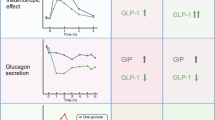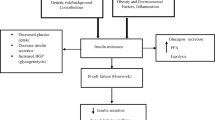Abstract
Aims
Spexin plays a role in regulating glucose metabolism. This study investigated the spexin levels in different glycemic status and its association with insulin secretion in humans.
Methods
A total of 462 subjects were recruited in this study, including 52 healthy subjects, 106 first-degree relatives (FDRs) of type 2 diabetes mellitus (T2DM), 115 impaired glucose regulation (IGR), 80 newly diagnosed T2DM, and 106 established T2DM. Serum spexin was measured using ELISA. The homeostasis model assessment of insulin resistance (HOMA2-IR) and β-cell function (HOMA2-β), and Stumvoll index estimating first- and second-phase insulin secretion were calculated.
Results
Spexin levels were higher in FDRs [235.53 pg/ml (185.28, 293.95)] and IGR [239.79 pg/ml (191.52, 301.69)], comparable in newly diagnosed T2DM [224.68 pg/ml (187.37, 279.74)], and lower in established T2DM [100.11 pg/ml (78.50, 137.34)], compared with healthy subjects [200.23 pg/ml (160.32, 275.65)]. Spexin levels were negatively correlated with fasting plasma glucose (FPG) (r = − 0.355, P < 0.001), hemoglobin A1C (HbA1c) (r = − 0.379, P < 0.001), and HOMA2-IR (r = − 0.225, P < 0.001), and positively correlated with HOMA2-β (r = 0.245, P < 0.001) after adjusting for age, sex, and BMI. Multivariate linear regression analysis showed that established T2DM and HOMA2-β were independently associated with serum spexin levels.
Conclusions
Serum spexin levels represented as a bell-shaped curve along the glycemic continuum and is closely related with insulin secretion in humans.


Similar content being viewed by others
References
Mirabeau O, Perlas E, Severini C et al (2007) Identification of novel peptide hormones in the human proteome by hidden Markov model screening. Genome Res 17:320–327
Wan B, Wang XR, Zhou YB, Zhang X, Huo K, Han ZG (2009) C12ORF39, a novel secreted protein with a typical amidation processing signal. Biosci Rep 30:1–10
Kim DK, Yun S, Son GH, et al (2014) Coevolution of the spexin/galanin/kisspeptin family: spexin activates galanin receptor type II and III. Endocrinology 155:1864–1873
Mills EG, Izzi-Engbeaya C, Abbara A, Comninos AN, Dhillo WS (2021) Functions of galanin, spexin and kisspeptin in metabolism, mood and behaviour. Nat Rev Endocrinol 17:97–113
Ge JF, Walewski JL, Anglade D, Berk PD (2016) Regulation of hepatocellular fatty acid uptake in mouse models of fatty liver disease with and without functional leptin signaling: roles of NfKB and SREBP-1C and the effects of spexin. Semin Liver Dis 36:360–372
Gu L, Ding X, Wang Y et al (2019) Spexin alleviates insulin resistance and inhibits hepatic gluconeogenesis via the FoxO1/PGC-1alpha pathway in high-fat-diet-induced rats and insulin resistant cells. Int J Biol Sci 15:2815–2829
Yu M, Wang M, Han S et al (2022) Spexin ameliorates skeletal muscle insulin resistance through activation of GAL2 receptor. Eur J Pharmacol 917:174731
Porzionato A, Rucinski M, Macchi V, Stecco C, Malendowicz LK, De Caro R (2010) Spexin expression in normal rat tissues. J Histochem Cytochem 58:825–837
Gu L, Ma Y, Gu M et al (2015) Spexin peptide is expressed in human endocrine and epithelial tissues and reduced after glucose load in type 2 diabetes. Peptides 71:232–239
Sassek M, Kolodziejski PA, Szczepankiewicz D, Pruszynska-Oszmalek E (2019) Spexin in the physiology of pancreatic islets-mutual interactions with insulin. Endocrine 63:513–519
Sassek M, Kolodziejski PA, Strowski MZ, Nogowski L, Nowak KW, Mackowiak P (2018) Spexin modulates functions of rat endocrine pancreatic cells. Pancreas 47:904–909
Karaca A, Bakar-Ates F, Ersoz-Gulcelik N (2018) Decreased spexin levels in patients with type 1 and type 2 diabetes. Med Princ Pract 27:549–554
Hodges SK, Teague AM, Dasari PS, Short KR (2018) Effect of obesity and type 2 diabetes, and glucose ingestion on circulating spexin concentration in adolescents. Pediatr Diabetes 19:212–216
Al-Daghri NM, Wani K, Yakout SM et al (2019) Favorable changes in fasting glucose in a 6-month self-monitored lifestyle modification programme inversely affects spexin levels in females with prediabetes. Sci Rep 9:9454
Akbas M, Koyuncu FM, Oludag Mete T, Taneli F, Ozdemir H, Yilmaz O (2019) Serum levels of spexin are increased in the third trimester pregnancy with gestational diabetes mellitus. Gynecol Endocrinol 35:1050–1053
Khadir A, Kavalakatt S, Madhu D et al (2020) Spexin as an indicator of beneficial effects of exercise in human obesity and diabetes. Sci Rep 10:10635
Mohammadi A, Bijeh N, Moazzami M, Kazem K, Rahimi N (2022) Effect of exercise training on spexin level, appetite, lipid accumulation product, visceral adiposity index, and body composition in adults with type 2 diabetes. Biol Res Nurs 24:152–162
Prentki M, Nolan CJ (2006) Islet beta cell failure in type 2 diabetes. J Clin Invest 116:1802–1812
Tabak AG, Herder C, Rathmann W, Brunner EJ, Kivimaki M (2012) Prediabetes: a high-risk state for diabetes development. Lancet 379:2279–2290
Poulsen P, Kyvik KO, Vaag A, Beck-Nielsen H (1999) Heritability of type II (non-insulin-dependent) diabetes mellitus and abnormal glucose tolerance–a population-based twin study. Diabetologia 42:139–145
Kahn SE, Hull RL, Utzschneider KM (2006) Mechanisms linking obesity to insulin resistance and type 2 diabetes. Nature 444:840–846
Zheng B, Li S, Liu Y et al (2017) Spexin suppress food intake in zebrafish: evidence from gene knockout study. Sci Rep 7:14643
Jeong B, Kim KK, Lee TH et al (2022) Spexin regulates hypothalamic leptin action on feeding behavior. Biomol 12(2):236
Walewski JL, Ge F, Lobdell HT et al (2014) Spexin is a novel human peptide that reduces adipocyte uptake of long chain fatty acids and causes weight loss in rodents with diet-induced obesity. Obesity (Silver Spring) 22:1643–1652
Lin CY, Huang T, Zhao L et al (2018) Circulating spexin levels negatively correlate with age bmi, fasting glucose, and triglycerides in healthy adult women,. J Endocr Soc 2:409–419
Kolodziejski PA, Pruszynska-Oszmalek E, Korek E et al (2018) Serum levels of spexin and kisspeptin negatively correlate with obesity and insulin resistance in women. Physiol Res 67:45–56
Kumar S, Hossain J, Nader N, Aguirre R, Sriram S, Balagopal PB (2016) Decreased circulating levels of spexin in obese children. J Clin Endocrinol Metab 101:2931–2936
Kumar S, Hossain MJ, Javed A, Kullo IJ, Balagopal PB (2018) Relationship of circulating spexin with markers of cardiovascular disease: a pilot study in adolescents with obesity. Pediatr Obes 13:374–380
Sonmez K, Zaveri NT, Kerman IA et al (2009) Evolutionary sequence modeling for discovery of peptide hormones. PLoS Comput Biol 5:e1000258
Liu Y, Li S, Qi X et al (2013) A novel neuropeptide in suppressing luteinizing hormone release in goldfish, Carassius auratus. Mol Cell Endocrinol 374:65–72
Alonso L, Piron A, Moran I et al (2021) TIGER: The gene expression regulatory variation landscape of human pancreatic islets. Cell Rep 37:109807
Walewski JL, Ge F, Gagner M et al (2010) Adipocyte accumulation of long-chain fatty acids in obesity is multifactorial, resulting from increased fatty acid uptake and decreased activity of genes involved in fat utilization. Obes Surg 20:93–107
Bitarafan V, Esteghamati A, Azam K, Yosaee S, Djafarian K (2019) Comparing serum concentration of spexin among patients with metabolic syndrome, healthy overweight/obese, and normal-weight individuals. Med J Islam Repub Iran 33:93
Song YS, Hwang YC, Ahn HY, Park CY (2016) Comparison of the usefulness of the updated homeostasis model assessment (HOMA2) with the original HOMA1 in the prediction of type 2 diabetes mellitus in Koreans. Diabetes Metab J 40:318–325
Stumvoll M, Mitrakou A, Pimenta W et al (2000) Use of the oral glucose tolerance test to assess insulin release and insulin sensitivity. Diabetes Care 23:295–301
Wu H, Lin F, Chen H et al (2016) Ya-fish (Schizothorax prenanti) spexin: identification, tissue distribution and mRNA expression responses to periprandial and fasting. Fish Physiol Biochem 42:39–49
Funding
This study was funded by the national nature science foundation of China (Grant Numbers 81200622).
Author information
Authors and Affiliations
Corresponding author
Ethics declarations
Conflict of interest
The authors declare that they have no conflict of interest.
Additional information
Managed by Massimo Federici.
Publisher's Note
Springer Nature remains neutral with regard to jurisdictional claims in published maps and institutional affiliations.
Supplementary Information
Below is the link to the electronic supplementary material.
Rights and permissions
Springer Nature or its licensor (e.g. a society or other partner) holds exclusive rights to this article under a publishing agreement with the author(s) or other rightsholder(s); author self-archiving of the accepted manuscript version of this article is solely governed by the terms of such publishing agreement and applicable law.
About this article
Cite this article
Dai, J., Ni, Y., Wu, D. et al. Circulating spexin levels are influenced by the glycemic status and correlated with pancreatic β-cell function in Chinese subjects. Acta Diabetol 60, 305–313 (2023). https://doi.org/10.1007/s00592-022-02010-x
Received:
Accepted:
Published:
Issue Date:
DOI: https://doi.org/10.1007/s00592-022-02010-x




